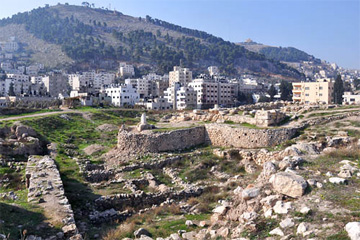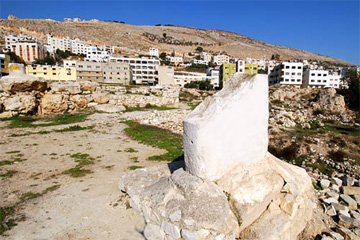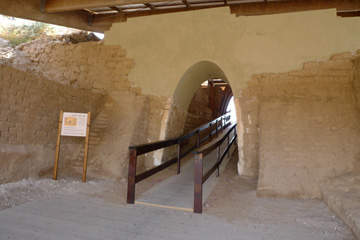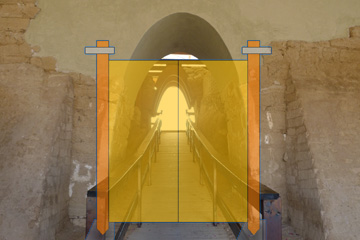Archaeology and the Bible
Judges
| Hazor | 33 01 02.25N 35 34 05.57E | The coordinates are for the tel of Hazor, which has been fairly intensively excavated (including by Yigael Yadin with a backhoe!) However there is a much larger "Lower City" in the enclosure to the north-west of the tel which has only been excavated in a couple of small areas. Note how the motorway under construction curves round the lower city, a fact for which we must be grateful - in an earlier age they would have simply built right over the site. One could wish, however, that the motorway had been kept far away. If you have 3D switched on, you can see how Hazor guarded a minor pass between the fertile plain to the north and the mountains to the south. |
| Shechem | 32 12 48.88N 35 16 56.84E | This is Tel Balata. There is not much to be seen in the picture and only three photographs on Panoramio, but it is believed to be the city of Shechem during the period of the judges. |
Deborah
There is little archaeological of relevance to the earlier judges whose deeds left no trace in stone or earth. Deborah, too, left no trace but the statement that her oppressor, Jabin king of Canaan, had 900 chariots of iron, implies that we are approaching the Iron Age. Tutankhamun, the wealthy boy-king of Egypt, lived in LBIIA and had two iron daggers buried with him as evidence of his great wealth and power - there was no question of him having iron chariots (whether made of iron or decorated with it).
In fact, iron was so scarce at the time of the Exodus that its use in a killing was prima facie evidence of murder (Number 35:16). No one would have an iron tool just lying around to be used in the heat of the moment or in an accident. Iron was reserved for weapons and if it was used to kill someone it meant that you had deliberately set out to murder.
Yet here we have a king armed with not just one but nine hundred "chariots of iron". It is not clear what the phrase might mean: iron, particularly in the early days, had few advantages over light wood for constructing chariots. Wood is flexible and easily repaired or replaced, iron was rigid, easy to fracture or bend and hard to repair. The only part of a chariot that might be usefully made of iron is the axle. However there is another possibility and that is that it was not the vehicles which were made of iron but the charioteers - in other words, the occupants of the chariot were armed with iron weapons. An iron sword could cut through a bronze one and leave its edge unimpaired and in addition the charioteers may have been protected by iron armour , which again would make them more fearsome.
When first founded in the Early Bronze Age the settlement was on the hill which later developed into the tel of Hazor. However in the Middle Bronze Age the city was vastly enlarged with a huge enclosure to the north-west surrounded by an earth rampart. Early visitors to the site referred to this as Sisera's chariot park but the excavations done in the area so far indicate that it was in fact a settled urban area.
The Bible says that the Israelites destroyed Jabin - which probably involved the destruction of his capital city - and there are signs of destruction by fire at the end of the Late Bronze Period when both Upper and Lower Cities were destroyed. Unfortunately there are no graffiti saying "Deborah waz 'ere", so we cannot be certain who was responsible for this destruction. Yigael Yadin attributed it to Joshua but was then faced with the problem that the site was subsequently deserted and was forced to conclude that the story of Deborah and Barak was not true.
I was much puzzled by this, for his conclusions seemed to be solidly founded. However a few years after reading his popular account of the excavations I happened to come across a technical report of his excavations in a library. There were no glossy photographs, no thrilling accounts of discoveries, just tediously repeated records of the types of pottery found at each level and the thickness of the strata and so on. In this fuller and more precise account he recorded that both areas of Hazor had been destroyed in a previous fire that happened 200 years before and which he guessed might be attributed to some unknown pharaoh.
Naturally I would blame this earlier destruction on Joshua, for in his time Hazor was "head of all those kingdoms", and the later destruction on Deborah and Barak. Of course, I might be wrong but it underlines a point not often appreciated: the archaeologists find facts on the ground - layers of ash, types of pottery, broken walls and ruined houses. However it is the interpretation of those facts that can often be in doubt and in this case I believe firmly that Yadin was mistaken. Deborah and Barak did exist and the ruins of Hazor bear witness to their victory in battle.
Interestingly, in 1992 archaeologists found a broken cuneiform tablet in the ruins of the palace at Hazor which was addressed to a king "Jabin". The document comes from the 18th century BC (conventional chronology), which is the wrong period for Deborah by anybody's chronology. However it would appear to indicate that "Jabin" was a dynastic name or possibly even a title, though it is equally possible that we have two or more individuals with the same name - a not unknown phenomenon even among European royalty.
Abimelech

| |
| The excavations at Tel Balata. The fortress temple and one of the standing stones is on top of the platform surrounded by a wall built by the excavators to conserve the site. |
Unfortunately neither man kept good records and the later excavations by G. Ernest Wright of the Drew-McCormick expedition were as much to try and make sense of the German work as to make new discoveries. Wright drew amazing parallels with the Biblical story, especially in regard to the fortress-like temple with walls 17' thick, which he linked to the story of Gideon's bastard son Abimelech. He identified this temple as Beth Millo mentioned in Judges 9:6.

| |
| The broken massebah stands in the courtyard in front of the Temple of Baal Berith at Shechem. |
There is a large massebah or stele in front of the temple. It is broken, so its original height is not known, and there is nothing written on or carved into the surface. However it is possible that the stone original had a plaster coating on which an inscription may have been written. Some have suggested that this was the "large stone" Joshua erected under an oak tree near the "sanctuary of Yahweh". If so it is intriguing to learn that the people of Shechem hosted a temple to the God of Israel!
Whether or not this is Joshua's stone, it is almost certainly the "pillar" where Abimelech was crowned by the people of Shechem after the massacre of his half-brothers. As such it is one of the few things in Palestine of which we can truly say, "A Bible character saw this and touched it."
Unfortunately the Germans had cleared the temple without leaving any adequate records of the pottery found associated with it, but in his book Shechem Wright was unequivocal. The building, its situation, the standing stone, the evidences of destruction, all meant that there could be no doubt that the temple was the very one which had been destroyed by Abimelech and that meant that it must be Iron Age.
Unfortunately, soon after his book was published evidence emerged from the excavation of the East Gate which more or less proved that the temple had been destroyed in Middle Bronze IIC, much too early to be Abimelech by the conventional chronology but fitting nicely with the requirements of the Revised Chronology.
Samson
No trace has been found of Israel's redoubtable strongman, but archaeology does shed some light on two episodes in his rather discreditable life. The first has to do with the occasion when, finding himself confronted by the Philistines but with no weapon to hand, he snatched up the jawbone of an ass and killed a thousand men. (Remember that eleph does not necessarily mean 1,000 but could mean "group" or "cohort"). Ancient sickles, whatever they were made of, tended to have a shape similar to half a jawbone and in numerous examples that have been discovered, actually were jawbones! In these cases the animal's teeth had been removed and razor-sharp flakes of flint glued into place with bitumen. Something like that in the hands of a strong man might indeed prove an effective weapon.

| |
| The Middle Bronze gateway into the Philistine city of Ascalon. The gateway is actually quite small - only three or four people could walk through abreast. |
The second is the incident of the gates of Gaza. According to the story Samson - who seems to have had an unhealthy obsession for sleeping with the enemy - visited a prostitute in Gaza. Somehow the locals discovered his identity and set up an ambush in the city gate, intending to kill him when he attempted to leave in the morning. Samson, however, only stayed until midnight then slipped out to where his would-be attackers were sleeping in the gateway.

| |
| Diagram of an ancient gate. Note the two posts to which the leaves of the gate were attached. |
"Then he got up and took hold of the doors of the city gate, together with the two posts, and tore them loose, bar and all. He lifted them to his shoulders and carried them to the top of the hill that faces Hebron."
Judges 16:3
I believe it was Gustav Dore who produced an engraving showing a muscle-bound man hefting two enormous gates which have been ripped out of the wall, complete with frame (the two posts), and staggering away from the shattered gateway with them on his back. It is certainly a dramatic picture, but it is based on European city gates. Bronze Age Middle Eastern gates were very different.

| |
| Here the diagram has been superimposed on a photograph of the gateway at Ascalon. |
Ancient gates were not mounted on hinges but on a pole to which the leaf of the gate was attached. The pole was then fed up through a stone or metal ring, or even just a hole in the stonework, at the top of the gate and levered into position with the base of the pole resting on a stone into which a slight hollow had been cut. To open or shut the gate you pushed on the leaf, the pole rotated on the base stone and the gate ground slowly round in the desired direction.
The photograph above on the left shows the size of a typical Middle Bronze Philistine gateway. Far from the massive slabs of timber in Dore's imagination, a single leaf may have been as small as three feet in width and six to eight feet in height. Heaving it up off the base stone, tipping the bottom out away from the wall and then easing it down to come free of the hole at the top of the gate was no doubt an arduous task and well beyond the capability of any ordinary man, but feasible for someone possessed of more than normal strength.
More to the point, someone with the necessary strength could accomplish this in relative silence - a bit of scraping as the gate came free of the stonework and that was all - whereas if Samson had attempted to smash his way through the gates the noise would have aroused his enemies. He didn't even break the bar which held the two gates shut: he simply lifted the entire contraption, slid it out of its mountings and strolled away with it.
Dan
The final part of the book of Judges records the story of the conquest of Dan. Excavations at Tel Dan have uncovered a magnificent Bronze Age gate still standing to a height of 22', the only such gateway completely preserved in the whole of the Middle East. (I suspect that the reconstruction of the Ascalon gateway is based in part on the Tel Dan gate. Curiously, there are no remains from the supposed time of the occupation of the tel by the tribe of Dan, despite the explicit statement that the men of Dan burned the city and rebuilt it for their own use.
It seems to me that the impressive gateway is, in fact, Israelite and the ramparts in which it stands were erected by the men of Dan, fearful lest their new neighbours mount an attack in revenge for the destruction of the Phoenician city. The excavators estimated that it must have taken a thousand men three years to pile up the earth for the one and a quarter mile long ramparts.
iron armour It is believed that the first horses were the size of ponies and too small to carry a man far or fast, whereas harnessing two or three to a chariot provided the speed and mobility without killing the animals. When larger horses were bred, chariots became obsolete.
As shown in Egyptian pictures, chariots were used to provide mobile firing platforms from which the charioteer could fire at the enemy. The tactics were to drive rapidly towards a group of enemy infantry, firing as soon as you came within range, then gallop along parallel to the enemy but out of range of his weapons, before retreating to reform, rearm and repeat the manoeuvre. Infantrymen were armed with spears, javelins and bows which are believed to have had a range of 60-90 yards. Charioteers, however, were armed with composite bows with a range of 180 yards.
Of course the enemy might also have chariots - at the Battle of Kadesh between the Egyptians and Hittites, a total of 5,000 chariots were on the field of battle - and he would use his chariots to impede or destroy your chariots. As protection, the charioteers wore scale armour - hundreds of metal "scales" sewn onto a linen or leather coat. Usually these scales were made of copper or bronze, but iron scales could be thinner and lighter while providing the same protection. That meant that the wearer could be more mobile if he was forced out of his chariot, the chariot could be faster (there was less weight for the horses to drag), and the armour provided more protection against bronze weapons than bronze or copper.
However there is another possibility. Although the Egyptians certainly fought in the manner described, other cultures may have used the chariot differently and it is possible that some, like the later Greeks, simply used the chariot to transport troops rapidly from one part of the battlefield to another. A small cloud of dust on the horizon could, within minutes, be transformed into a group of iron-clad warriors who charged to the attack before you had a chance to get into formation to receive them.
At one time it was claimed that the introduction of a plastered glacis on the sloping sites of many tels was a result of the introduction of chariots, but as Yadin himself remarked, a horse's nose is not terribly effective against a stone wall. It is more likely that the glacis was a response to the threat of battering rams. Return
"Jabin" In fact the document refers to "Ibni Addu" but "Ibni" is easily transformed into "Jabin" according to well-understood rules. 'J' is, in fact, 'Y' and 'Y' represents the 'I' sound as in "Israel", which is actualy "Yisrael". "Jabin" instead of "Jabni" is again typical of translations between languages and writting methods. Return





